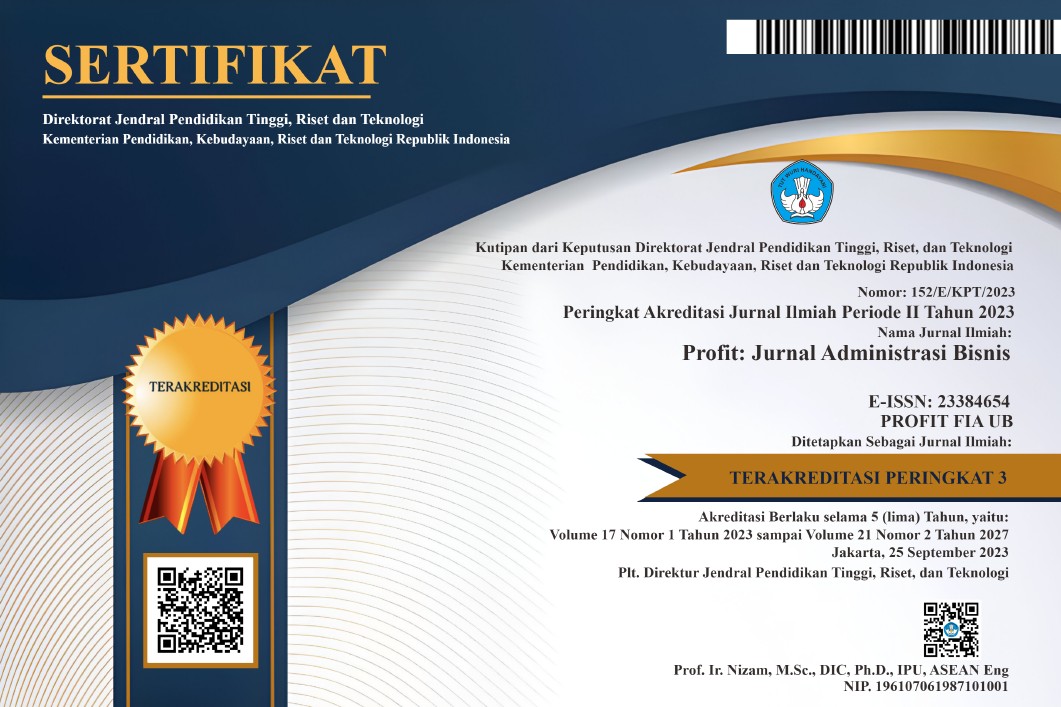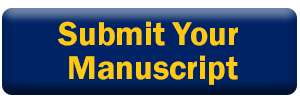ANALISIS DESTINATION IMAGE TERHADAP REVISIT INTENTION MELALUI SATISFACTION DAN PLACE ATTACHMENT: LITERATURE REVIEW
DOI:
https://doi.org/10.21776/ub.profit.2022.-16.01.16Keywords:
Literature Review, Destination Image, Satisfaction Place Attachment, Revisit IntentionAbstract
ABSTRACT
This literature review aims to examine the antecedent factor of one form of tourist loyalty, namely the revisit intention. This study was carried out by searching and filtering articles from reputable journals that match the problem, then presenting relevant theories to the research topic. Based on the results of this literature review, the authors found that destination image, satisfaction, and place attachment were antecedents of revisit intention. The image of a destination received by tourists after making a visit will affect the satisfaction and attachment that occurs between the tourists themselves and the destination visited, which leads to the intention to revisit. This literature review concludes several implications, especially for tourism service providers for their tourist destinations, thus forming a positive image for tourists and leading to the intention to revisit.
References
DAFTAR PUSTAKA
Alexandries, K., Kouthouris, C., & Meligdis, A. (2006). Increasing customers ’ loyalty in a skiing resort The contribution of place attachment and. International Journal of Contemporary Hospitality Management, 18(5), 414–425. https://doi.org/10.1108/09596110610673547
Baloglu, S., & McCleary, K. W. (1999). A model of destination image formation. Annals of Tourism Research, 26(4), 868–897. https://doi.org/10.1016/S0160-7383(99)00030-4
Beerli, A., & Martín, J. D. (2004). Factors influencing destination image. Annals of Tourism Research, 31(3), 657–681. https://doi.org/10.1016/j.annals.2004.01.010
Bigné, J. E., Sánchez, M. I., & Sánchez, J. (2001). Tourism image, evaluation variables and after purhase behaviour: Inter-relationship. Tourism Management, 22(6), 607–616. https://doi.org/10.1016/S0261-5177(01)00035-8
Briner, R. B., & Denyer, D. (2012). Systematic Review and Evidence Synthesis as a Practice and Scholarship Tool. The Oxford Handbook of Evidence-Based Management, (January). https://doi.org/10.1093/oxfordhb/9780199763986.013.0007
Chen, C. F., & Tsai, D. C. (2007). How destination image and evaluative factors affect behavioral intentions? Tourism Management, 28(4), 1115–1122. https://doi.org/10.1016/j.tourman.2006.07.007
Chiu, W., Zeng, S., & Cheng, P. S. T. (2016). The influence of destination image and tourist satisfaction on tourist loyalty: a case study of Chinese tourists in Korea. International Journal of Culture, Tourism, and Hospitality Research, 10(2), 223–234. https://doi.org/10.1108/IJCTHR-07-2015-0080
Gibson, H. J., Qi, C. X., & Zhang, J. J. (2008). Destination Image and Intent to Visit China and the 2008 Beijing Olympic Games. Journal of Sport Management, 22, 427–450.
Han, J. H., Kim, J. S., Lee, C. K., & Kim, N. (2019). Role of place attachment dimensions in tourists’ decision-making process in Cittáslow. Journal of Destination Marketing and Management, 11(December 2018), 108–119. https://doi.org/10.1016/j.jdmm.2018.12.008
Hasan, M. K., Abdullah, S. K., Lew, T. Y., & Islam, M. F. (2019). The antecedents of tourist attitudes to revisit and revisit intentions for coastal tourism. International Journal of Culture, Tourism, and Hospitality Research, 13(2), 218–234. https://doi.org/10.1108/IJCTHR-11-2018-0151
Inalhan, G., & Finch, E. (2004). Place attachment and sense of belonging. Facilities, 22(5), 120–128. https://doi.org/10.1108/02632770410540333
Jiang, Y., Ramkissoon, H., Mavondo, F. T., & Feng, S. (2017). Authenticity: The Link Between Destination Image and Place Attachment. Journal of Hospitality Marketing and Management, 26(2), 105–124. https://doi.org/10.1080/19368623.2016.1185988
Kaplanidou, K. K., Jordan, J. S., Funk, D., & Rindinger, L. L. (2012). Recurring sport events and destination image perceptions: Impact on active sport tourist behavioral intentions and place attachment. Journal of Sport Management, 26(3), 237–248. https://doi.org/10.1123/jsm.26.3.237
Kyle, G., Graefe, A., & Manning, R. (2005). Testing the dimensionality of place attachment in recreational settings. Environment and Behavior, 37(2), 153–177. https://doi.org/10.1177/0013916504269654
Lee, J., Kyle, G., & Scott, D. (2012). The Mediating Effect of Place Attachment on the Relationship between Festival Satisfaction and Loyalty to the Festival Hosting Destination. Journal of Travel Research, 51(6), 754–767. https://doi.org/10.1177/0047287512437859
Lee, T. H., & Shen, Y. L. (2013). The influence of leisure involvement and place attachment on destination loyalty : Evidence from recreationists walking their dogs in urban parks. Journal of Environmental Psychology, 33, 76–85. https://doi.org/10.1016/j.jenvp.2012.11.002
Loi, L. T. I., So, A. S. I., Lo, I. S., & Fong, L. H. N. (2017). Does the quality of tourist shuttles influence revisit intention through destination image and satisfaction? The case of Macao. Journal of Hospitality and Tourism Management, 32, 115–123. https://doi.org/10.1016/j.jhtm.2017.06.002
Loureiro, S. M. C. (2014). The role of the rural tourism experience economy in place attachment and behavioral intentions. International Journal of Hospitality Management, 40, 1–9. https://doi.org/10.1016/j.ijhm.2014.02.010
Loureiro, S. M. C., Romero, J., & Bilro, R. G. (2019). Stakeholder engagement in co-creation processes for innovation: A systematic literature review and case stud. Journal of Business Research, (February 2018), 0–1. https://doi.org/10.1016/j.jbusres.2019.09.038
Manzo, L. C. (2003). Beyond house and haven: toward a revisioning of emotional relationships with places. Journal of Environmental Psychology, 23, 47–61.
Manzo, L. C. (2005). For better or worse: Exploring multiple dimensions of place meaning. Journal of Environmental Psychology, 25(1), 67–86. https://doi.org/10.1016/j.jenvp.2005.01.002
Önder, I., & Marchiori, E. (2017). A comparison of pre-visit beliefs and projected visual images of destinations. Tourism Management Perspectives, 21, 42–53. https://doi.org/10.1016/j.tmp.2016.11.003
Pike, S. (2002). Destination image analysis - A review of 142 papers from 1973 to 2000. Tourism Management, 23(5), 541–549. https://doi.org/10.1016/S0261-5177(02)00005-5
Plunkett, D., Fulthorp, K., & Paris, C. M. (2019). Examining the relationship between place attachment and behavioral loyalty in an urban park setting. Journal of Outdoor Recreation and Tourism, 25(November 2018), 36–44. https://doi.org/10.1016/j.jort.2018.11.006
Prayag, G. (2009). Tourists’ evaluations of destination image, satisfaction, and future behavioral intentions-the case of mauritius. Journal of Travel and Tourism Marketing, 26(8), 836–853. https://doi.org/10.1080/10548400903358729
Prayag, G., & Ryan, C. (2012). Antecedents of tourists’ loyalty to mauritius: The role and influence of destination image, place attachment, personal involvement, and satisfaction. Journal of Travel Research, 51(3), 342–356. https://doi.org/10.1177/0047287511410321
Ramseook-Munhurrun, P., Seebaluck, V. N., & Naidoo, P. (2015). Examining the Structural Relationships of Destination Image, Perceived Value, Tourist Satisfaction and Loyalty: Case of Mauritius. Procedia - Social and Behavioral Sciences, 175(230), 252–259. https://doi.org/10.1016/j.sbspro.2015.01.1198
Scannell, L., & Gifford, R. (2010). Defining place attachment : A tripartite organizing framework. Journal of Environmental Psychology, 30(1), 1–10. https://doi.org/10.1016/j.jenvp.2009.09.006
Shamsuddin, S., & Ujang, N. (2008). Making places: The role of attachment in creating the sense of place for traditional streets in Malaysia. Habitat International, 32(3), 399–409. https://doi.org/10.1016/j.habitatint.2008.01.004
Sharma, P., & Nayak, J. K. (2018). Testing the role of tourists’ emotional experiences in predicting destination image, satisfaction, and behavioral intentions: A case of wellness tourism. Tourism Management Perspectives, 28(December 2017), 41–52. https://doi.org/10.1016/j.tmp.2018.07.004
Song, H. M., Kim, K. S., & Yim, B. H. (2017a). The mediating effect of place attachment on the relationship between golf tourism destination image and revisit intention. Asia Pacific Journal of Tourism Research, 22(11), 1182–1193. https://doi.org/10.1080/10941665.2017.1377740
Song, H. M., Kim, K. S., & Yim, B. H. (2017b). The mediating effect of place attachment on the relationship between golf tourism destination image and revisit intention. Asia Pacific Journal of Tourism Research, 22(11), 1182–1193. https://doi.org/10.1080/10941665.2017.1377740
Stylos, N., Bellou, V., Andronikidis, A., & Vassiliadis, C. A. (2017). Linking the dots among destination images, place attachment, and revisit intentions: A study among British and Russian tourists. Tourism Management, 60, 15–29. https://doi.org/10.1016/j.tourman.2016.11.006
Stylos, N., Vassiliadis, C. A., Bellou, V., & Andronikidis, A. (2016). Destination images, holistic images and personal normative beliefs: Predictors of intention to revisit a destination. Tourism Management, 53, 40–60. https://doi.org/10.1016/j.tourman.2015.09.006
Um, S., Chon, K., & Ro, Y. H. (2006). Antecedents of revisit intention. Annals of Tourism Research, 33(4), 1141–1158. https://doi.org/10.1016/j.annals.2006.06.003
Xu, Z., & Zhang, J. (2016). Antecedents and consequences of place attachment : A comparison of Chinese and Western urban tourists in Hangzhou , China. Journal of Destination Marketing & Management, 1–11. https://doi.org/10.1016/j.jdmm.2015.11.003
Yeap, J. A. L., Ong, K. S. G., Yapp, E. H. T., & Ooi, S. K. (2019). Hungry for more: understanding young domestic travellers’ return for Penang street food. British Food Journal, (2017). https://doi.org/10.1108/BFJ-09-2018-0632
Yeh, S. S., Chen, C., & Liu, Y. C. (2012). Nostalgic emotion, experiential value, destination image, and place attachment of cultural tourists. In Advances in Hospitality and Leisure (Vol. 8). https://doi.org/10.1108/S1745-3542(2012)0000008013
Yoon, Y., & Uysal, M. (2005). An examination of the effects of motivation and satisfaction on destination loyalty: A structural model. Tourism Management, 26(1), 45–56. https://doi.org/10.1016/j.tourman.2003.08.016
Yüksel, A., & Yüksel, F. (2001). The Expectancy-Disconfirmation Paradigm: A Critique. Journal of Hospitality and Tourism Research, 25(2), 107–131. https://doi.org/10.1177/109634800102500201
Zhang, H., Fu, X., Cai, L. A., & Lu, L. (2014). Destination image and tourist loyalty: A meta-analysis. Tourism Management, 40, 213–223. https://doi.org/10.1016/j.tourman.2013.06.006
Downloads
Published
Issue
Section
License
Copyright (c) 2022 PROFIT: JURNAL ADMINISTRASI BISNIS

This work is licensed under a Creative Commons Attribution-NonCommercial 4.0 International License.
The copyright of the received article shall be assigned to the journal as the publisher of the journal. The intended copyright includes the right to publish the article in various forms (including reprints). The journal maintains the publishing rights to the published articles.

This work is licensed under a
Creative Commons Attribution-NonCommercial 4.0 International License

















